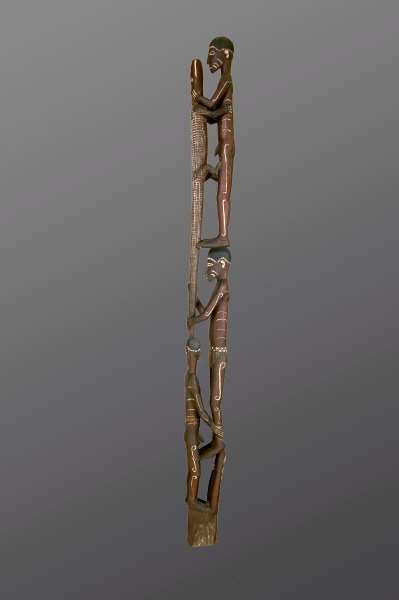|
|
Go back ...
The Cosmogony:
The Asmat do not try to understand or resolve the origin of the universe, they do not wish to define the existence of a supreme being who created, protected and ruled the cosmos. The essential issue for them is to understand “how can the human being exist and survive in this world”. Mankind, animals, plants, have a soul and are imbued with spirituality. It is what Religious Studies call primitive animism: the external world is animated by spirits, each with its own specific power. Any manifestation of live is endowed with sacred and profane characteristics, the only separation is between visible and invisible spirits, which always coexist. Their presence hovers all around, at the bottom of the rivers, in whirlpools, in the upper world and afterworld.
The Asmat myth of the origins narrates that Fumeripits, who was the first human being on earth, created the jeu, the men’s ceremonial house, the sacred dwelling where the Asmat male population meets regularly, discusses the problems of the community, celebrates rites and ceremonies, carves the wood. Fumeripits spent his days dancing along the beach, but solitude led him to a state of melancholia. He decided to cut down some trees and started to carve human figures and placed them inside the jeu.
However, since the sculptures were inanimate, Fumeripits was still unhappy. He chopped down another tree, hollowed out the center, and stretched a piece of lizard skin over the top. As he began to play the drum, the human figures miraculously came to life, their elbows came unstuck from their knees, and they began to dance. This is why the Asmat believe there is a strong connection between the human beings and trees, they recognize the wood as a life giving element.
|
|

|
To commemorate their creator, they continue in the strong tradition of carving. The master carvers, known as wowipits, hold a prestigious position in the community and believe it is a sacred duty to preserve this art from extinction as a vital and spontaneous expression of the inner and spiritual world.
The carvings are the incarnation of the ancestral spirits that rule the universe. They witness the vital interdependence between the material and immaterial world. To give order to the cosmos, today the Asmat appease the spirits of the ancestors with celebrations, while sorties, headhunting and ritual cannibalism were instruments used in the past.
The rituals are very complex and have to be carried out in a correct way in order to be effective. The carving of the ancestor poles is a means to keep the spirits of the dead alive.
In costume rituals, the spirits of deceased family members return to celebrate with the living and to give their unceasing assistance, animating the body masks made of plaited cordage composed of rattan, bark, and sago leaf fiber. The costumes are usually painted with red and white pigments. Magic is also a means to control spiritual power. Magic potions and formulas are used frequently but are kept secret.
To ensure the well-being of the community it is necessary to preserve the equilibrium and harmony between the world of the living and the world of the dead. The art of carving provided this balance, the statues named after the ancestors protected the warriors before a raid. Once the revenge was taken, the ritual prescribed the spilling of the enemy’s blood on the basis of the totem, to release the spirit of the deceased. If this was not done, his soul would wander among the living, causing epidemies and famine in the village.
Similarly, also headhunting and cannibalism acquired an inherent sense in the Asmat system of belief. It is fundamental to maintain stability in the universe to ensure survival and order within the society. Everyday activities are ruled by a complex philosophy in the pursuit of this equilibrium. To neglect this code would generate illness, death, hunger and other misfortunes, unless it is immediately corrected. Deaths and births are moments of an attempted balance between the number of the deceased and the spirits. Only old people and children could have a “natural” end to their lives, all the others perished at the hand of their “enemies” either directly, warring, or undirectly, through magic. In the past, it was considered an act of social responsibility to remedy a death in the village with the killing of an enemy. It is important to preserve a stable equilibrium with the spirits of the deceased, with enemies, friends, family and the sorrounding environment. Reciprocation in the relations produces harmony.
|
|
|